Fence Repair Guide
Need a fence repair?
This article will cover labour and supply costs, timeframes, DIY, pros and cons, design ideas, and what to check when hiring a tradesperson for a fence repair.
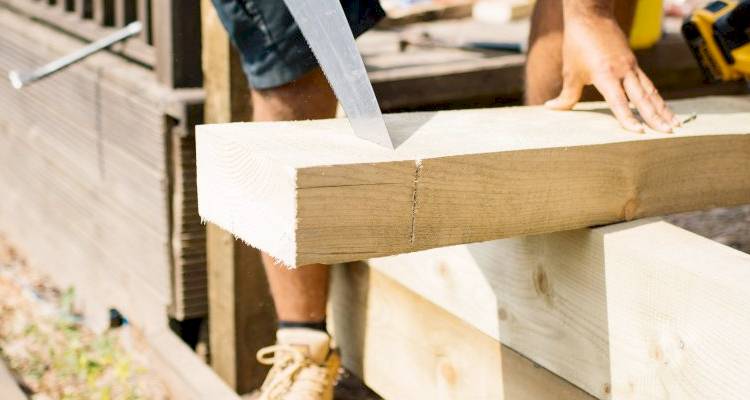
Table of Contents
- What is Fence Repair?
- What Maintenance Should I Be Doing?
- Types of Fencing Repairs
- What Are the Pros and Cons of Repairing a Garden Fence?
- How to Repair a Fence
- How Long Does It Take to Repair Fencing?
- Building Regulations or Planning Permission Approval for Fence Repairs
- How to Clean and Maintain Fences
- Questions to Ask When Getting Fence Repair Quotes
- FAQs
What is Fence Repair?
If you have a wooden fence around your property with proper upkeep and maintenance, it can last for up to 12 years if made of cheap, budget untreated timber.
However, if it is made of pressure-treated lumber, you can get up to 30 years or even more from your fence before you have to replace it!
The weather is the main culprit of damaged fencing and the need for fence repairs.
Heavy rainfall, snowstorms, harsh winds, and salt air can all cause degradation of your fence, or, in some cases, repairing a fence may be due to vehicle damages, vandals or an insect infestation.
What Common Repairs Need to Be Carried Out?
- If your fence has wet or dry rot, remove the infected area using a saw. Then patch or replace with new timber to prevent any of the rot from spreading.
- Rusted or popped nails sticking out of your fence need replacing asap to prevent them from causing injury to people or animals or snagging your clothes. This can be a quick fix.
- Sometimes your fence can sag or become wobbly due to dampness or other weather conditions. If this happens, you need to support the sagging area with a brace or tension rod and make a fencing repair immediately.
- Fence posts will often sag due to either the post itself, which has rotted or the hole it has been put into. If this is a problem for your fence, you should fill in the hole with crushed stone or concrete if the hole is too big for the post or replace the rotten post.
What Maintenance Should I Be Doing?
Fence maintenance by repairing a garden fence is the best way to avoid most problems. With only a few regular checks and using simple procedures to make garden fence repairs, your fence will continue to look pristine!
Proper maintenance will help preserve your fence, but it can’t always protect it from damage.
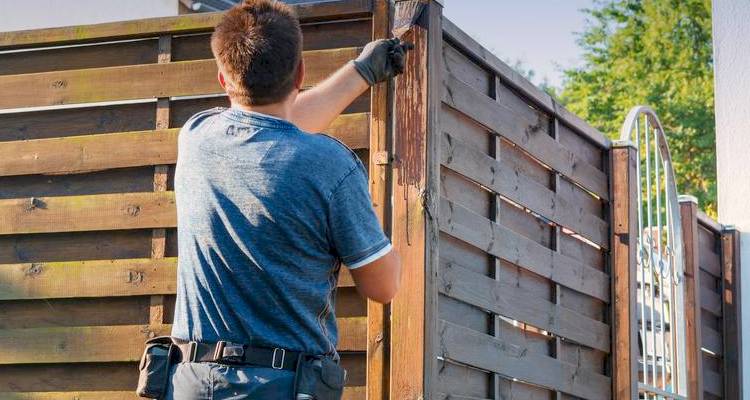
A good sealer will keep the fence looking good for a long time and avoid a higher fence repair cost.
Re-apply a sealer every three to five years and regularly pressure wash and varnish your fence to keep it in great condition and avoid costly fencing repairs.
Types of Fencing Repairs
Fences get damaged in many ways, including mould, rot, unstable posts, loose panels, and attack by insects. In these instances, you have two options – repair or try to find out how to repair a fence or replace some or all of it.
You may be good at DIY and fixing fencing and can lay the fence yourself, or you could find local fencing repairs or handyman fence repairs advertised in the local press.
They will also undertake fence panel repairs and fence post repairs at the same time at a price to suit your pocket.
Wooden Fences
There are many types of wooden fencing, and due to the organic nature of wood, they can be susceptible to mould, rot and insects. Panels and posts can become loose over time due to windy conditions.
Metal Fences
Fences, such as chain-link and wrought iron, can be badly damaged by the weather. When not properly protected by paint, moisture will cause them to rust.
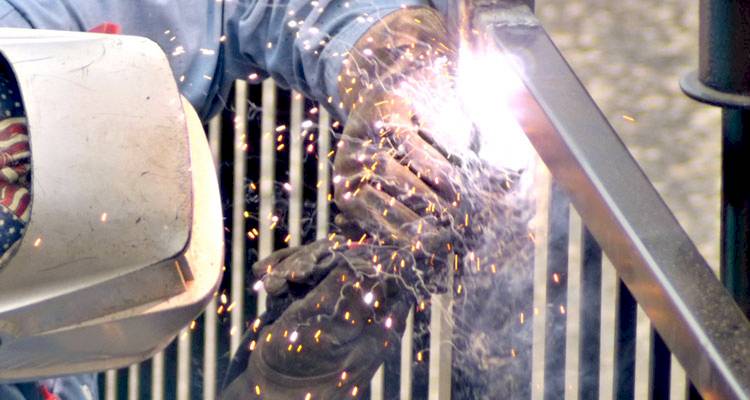
Other damage includes paint peeling and damage from impact, causing bending and sometimes knocking the fence down completely.
PVC Fences
Very durable and strong, PVC fences will only need to have small cracks or holes repaired, which will only happen if the fence is very old.
Electric Fences
Used to control livestock, these fences can be damaged by the weather or hit by a hard object or animal.
The type of fence being fixed affects the cost. For example, a small hole in a wooden fence can be cheaply repaired as the wood cost to patch this is not expensive.
On the other hand, repairing a metal fence can be much more complex and time-consuming, pushing up the cost.
What Are the Pros and Cons of Repairing a Garden Fence?
As with most fencing, there are pros and cons with timber. Timber is a naturally versatile and durable resource and an important organic construction material.
Pros
- ✔ Fencing will look clean and stylish.
- ✔ Affordable rather than a complete replacement.
- ✔ A sustainable friendly option.
- ✔ Environmentally friendly.
- ✔ Pressure treated timber is made to last.
- ✔ Quality components.
- ✔ Easy to fit.
- ✔ A simple lick of paint in a new colour or a new stain can breathe new life into your fence.
Cons
- ✖ Timber weathers and changes colour over time.
- ✖ Fencing is susceptible to damage from the elements, including rain, storms, hot and cold weather.
- ✖ Susceptible to rot, warps and insect damage.
- ✖ Variable quality.
- ✖ If not repaired properly, damaged fence posts can cause panels to fall, potentially damaging property and causing accidents.
How to Repair a Fence
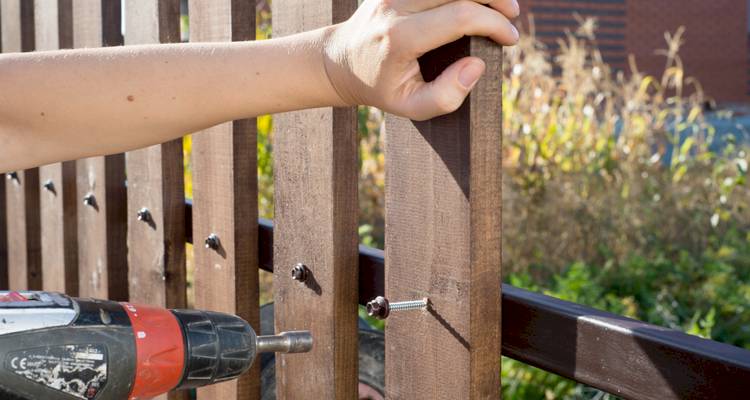
Just because a section of fencing is damaged doesn't mean the whole fence has to be replaced. Follow these fence repair tips.
Always repair fencing with the most rot-resistant timber you can afford. Pressure-treated timber is saturated with preservatives and can last for decades, even when buried in the ground.
Depending on how rotted the joint is, a rail that's pulled loose from one or more of its posts may be salvageable. You could mend the break with a 2x4 scrap or a couple of metal T-braces.
How to repair a rail with a 2x4:
- saturate damaged areas and a 2x4 liberally with a wood preservative to prevent the rot from spreading.
- Support the rail with a cleat to make sure the rail is level, then fit a 2x4 underneath. Nail the 2x4 to the post with galvanised nails. Hammer a couple of nails down through the rail into the cleat.
How to use galvanised T-braces in rail repair:
- Level and drill pilot holes into the post and rail.
- Secure the T-braces to the rail with galvanised screws.
If the whole rail needs replacing, dismantle that section of fence and rebuild it.
- Make 2x4 rails to fit along the tops of the posts.
- Nail rails in place using galvanised nails.
- Measure and cut the bottom rail to fit neatly between each pair of posts.
- Nail the bottom rails into place with galvanised nails, driven in at an angle through the fence post.
- Measure and cut the fence boards. They should be of uniform length.
- Nail the boards to a single side of the railings, leaving equal space between each one.
- Secure each board to the rails using galvanised nails at the top and two at the bottom.
Cracks and Splits in Fence
It might look minor now, but a crack in your fence panels or posts could finish off your entire fence.
- Use waterproof glue designed specifically for wood and outdoor use.
- Clean any loose debris out of the cavity.
- Put some glue onto your fence so that the glue covers the crack and inside the split. Ensure that it’s covered thoroughly, and it is a thick enough coat to hold everything together.
- Use strong clamps to hold the split glued wood together and leave it to dry for several hours.
- Once you’ve removed the clamps, the glue will have to set properly, making a good seal.
Rotten Fence
If you notice your fence panels or posts are rotten beyond repair, they will need to be removed and replaced.
Your replacement post or panel needs to be the same size as the old one so it fits perfectly into the existing fence structure. A good way to protect your new fence post is to use a fence post made of pressure-treated wood or a wooden post fitted into a concrete post.
- Detach the rotten piece from the healthy fence panels so you don't cause further damage to the structure.
- Dig the base of the fence post out using a shovel. If it's set in concrete, you'll have to break into it. Clear out the hole of debris.
- Coat the wood with a thick layer of wood preservative and allow it to dry thoroughly before placing it in the ground. This will prevent any more rotting.
- Put the new post into the hole, and brace it temporarily. Then, fill the hole with concrete or post mix.
- Use a waterproof seal at the base of the post with a waterproofing agent and a suitable outdoor sealant.
Wobbly Fence
If your fence has become wobbly, it's possibly due to the wood shrinking in the ground or the post becoming rotten.
- Fill in the gaps around the fence post with soil, gravel or post mix to stabilise it.
- Use a tamper or a length of wood to compact the material into any of the gaps and allow it to dry, and it should stay in place.
- If there is no concrete footing at your fence's base, add a supporting second post. This second post should be a little thinner than the wobbly post, but the same width. It should sit alongside the wobbly post in the ground. You can then bolt the two posts together to strengthen the weaker post.
Leaning Fence
A leaning fence is also a straightforward fence repair.
- Detach the leaning posts or panels from any surrounding fence structures.
- Dig up the post, breaking up the concrete and clearing it away. If the fence post is undamaged, you can re-use it. If the post is rotten, replace it with a new post.
- Put your post or replacement post back into the ground, brace it to keep it upright, and pour the new concrete footing in. When the footing has set, reassemble the fence using new galvanised nails, making sure everything is tight and strong.
- When undertaking any fencing project, ask for assistance.
- Always wear protective safety gear when necessary.
- If using concrete, wash your hands after use as wet cement can burn.
- Don’t allow concrete to dry on your tools. Clean it off with a stiff brush.
How Long Does It Take to Repair Fencing?
The time it takes to mend a fence depends upon the damage you need to repair. Will a repair job sort the problem or is it time to bite the bullet and completely replace the fence? Replacing a fence completely will normally take just 1 – 2 days.
Keeping fences in good repair adds value to your property and increases the security of your property. If you have an electric fence surrounding your property, then electric fence repairs may take longer if they need to be undertaken by a qualified contractor.
Concrete footings used in the base of your fencing are an important element of your fence's integrity and strength. Because of this reason alone, it is important to take care of fence repairs quickly.
When fence posts have become loose, it is usually due to problems in the footing. Over time, footings can crack or move and often prove very difficult to repair. The best solution is often to replace the entire fence post and the footings.
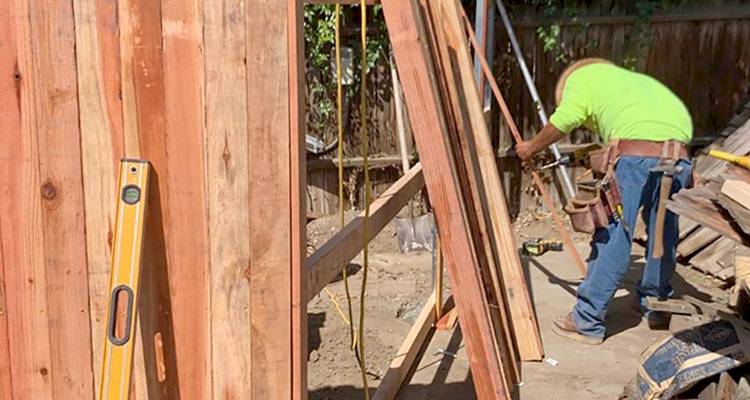
If you have earth and gravel footings, simply dig out as much of the backfill as possible and then re-plumb the fence post. By backfilling and tamping the integrity of the fence post will be restored.
When posts have rotted beyond repair, they can be replaced with a new post using new footings in the same location. Sometimes, this project may threaten the rest of the fence's strength and integrity, and it will require lots of work. If this is what's happened to your fence, it may be better to reinforce the old post with another post or a partial post.
You repair damaged concrete posts by shoring up the fence on all sides of the broken posts. Place blocks beneath the rails. Any backfill should then be removed down to the bottom of the post. If there is a concrete footing, you should dig a new post hole next to the old one. The old fence post can then be removed an inch or two above the ground. Try to wiggle the post free of concrete and lift it out with the assistance of a helper.
Add gravel inside the base of the hole. Cut a new post from the bottom of the hole to around three feet above the ground. Then cut the top at an angle to help the post shed water. Set the uncut end of the post into the ground. Add more gravel into the hole, then tamp it down.
After mixing your concrete with a handheld concrete mixer, fill the hole with concrete. Once the concrete has set, remove any bracing or blocks you have used.
Projects such as fence post replacement and concrete footing replacement can be made much easier using concrete tools such as a concrete mixer. Making sure the concrete is mixed properly is essential. When concrete is not mixed properly, problems can result. Sometimes these problems will not show until much later.
Fixing a stretch of broken barbed wire fencing can be done quickly! You will need:
- Fencing sleeves
- Crimping tool - (Optional)
- Heavy-duty pliers
- Gripple sleeves - (Optional)
Using a fence stretcher, pull together enough wire to repair the break. From each half of the wire, remove any barbs for about 6 to 8 inches. Slide each wire end through one gripple sleeve. They are inexpensive and available from many hardware stores or online.
To make the splice secure, separate both strands of the two-wire ends. Wrap each wire around the barbed wire. One strand is wrapped counter-clockwise around the wire.
The second strand is used to make a loop over the first wire before securing it in place. It is then wrapped in a clockwise direction several times over the barbed wire. The remaining loose ends should be cut off, and the same wraps should be made on the opposite side of the sleeve.
Building Regulations or Planning Permission Approval for Fence Repairs
If you want to put up a new; or alter, maintain, improve or take down an existing fence, wall or gate, you will not need to apply for planning permission provided the following conditions are met:
- Regarding the height of the fence:
- If the fence is next to a highway used by vehicles (or the footpath of such a highway) and will not be more than one metre high (from ground level); or
- it won't be more than two metres high (from ground level); or
- if an existing fence, wall, or gate already exceeds the limits above, its height would not increase.
- No part of the site can be a listed building or fall within the area surrounding a listed building.
- No part of the fence, wall, gate or any other boundary involved will form a boundary with a neighbouring listed building or its curtilage.
- The right to put up or alter fences, walls and gates has not been removed by an article four direction or a planning condition.
If you don’t meet these conditions, you will need to apply for planning permission and pay a fee. If in doubt, visit your local planning department for updated advice.
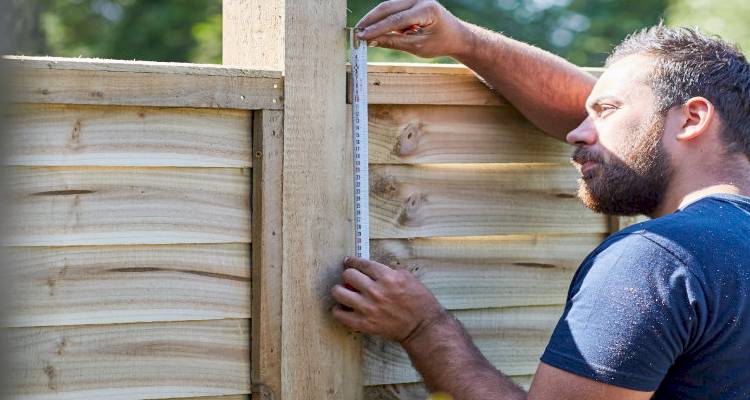
How to Clean and Maintain Fences
Here are some ways to keep your fence healthy over the years:
To clean a wooden fence, all you need is a pressure washer. If you haven’t got one of these, then here’s a list of items you’ll need:
- Bucket
- Sodium bicarbonate-based cleaner
- Scrubbing brush
- Cloth
- Hosepipe
- Washing up liquid.
If you don't have a pressure washer fill a bucket with warm soapy water and scrub the wooden fence with a household scrubbing brush. Use circular motions to buff the dirt away, then rinse the fence with fresh water.
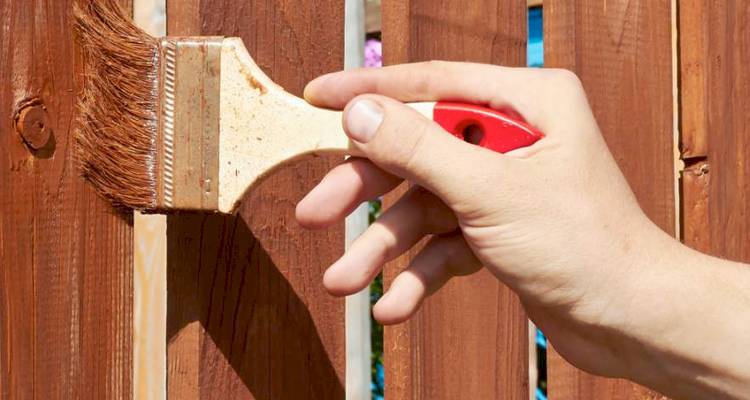
If you do own a pressure washer, hold it approximately 8 inches away from the surface of the fence. Remove any stubborn stains and algae growth by moving it around to clean interwoven or overlapping fence panels.
UPVC Fences
For this task, you will need a soft cloth and warm soapy water. Avoid bleach products when cleaning a UPVC fence, as this will stain the fence. Use a hard scrubbing brush as the bristles from the wire brush will scratch the plastic causing permanent damage.
Metal Fences
A dirty or weather-worn metal fence will need to be scrubbed with a wire brush. Scrub the metal fence with warm soapy water to remove any build-up of dirt and debris. This will also remove flaking paint or rust patches. Once the metal fence has dried, treat it with a rust inhibitor before repainting it.
Questions to Ask When Getting Fence Repair Quotes
Once you have decided on the material you want to use for your fence and have shortlisted specialist fencers, here are a few questions you need to ask to ensure that you have a good builder.
1. How Long Has Your Business Been Going?
No matter how small your fencing project, you will need a specialist with a good track record.
2. Can I See Your Past Projects?
Specialist companies should be happy to show off their work. You can ask past customers to vouch for the quality of their work or search their reviews online.
3. Do You Carry Insurance?
Liability insurance keeps your property, and yourself protected from any damages caused by the fencing specialist while doing your fencing project.
4. Can You Provide a Quote?
A good fencing specialist will visit your property to take measurements to give you a quote.
5. How Long Will the Project Take?
Ask for a reasonable timeline of how long the fencing will take. An experienced fencing specialist will discuss this with you.
6. How Do You Avoid Underground Utility Lines?
Buried utility lines can sometimes delay the work done on your property. Ensure they locate and mark any buried water, power, and gas lines to avoid them when building your fence.
7. What Is the Installation Warranty?
The long installation warranty period gives you an idea of the quality of the work. It shows the builders are confident with their quality of work.








